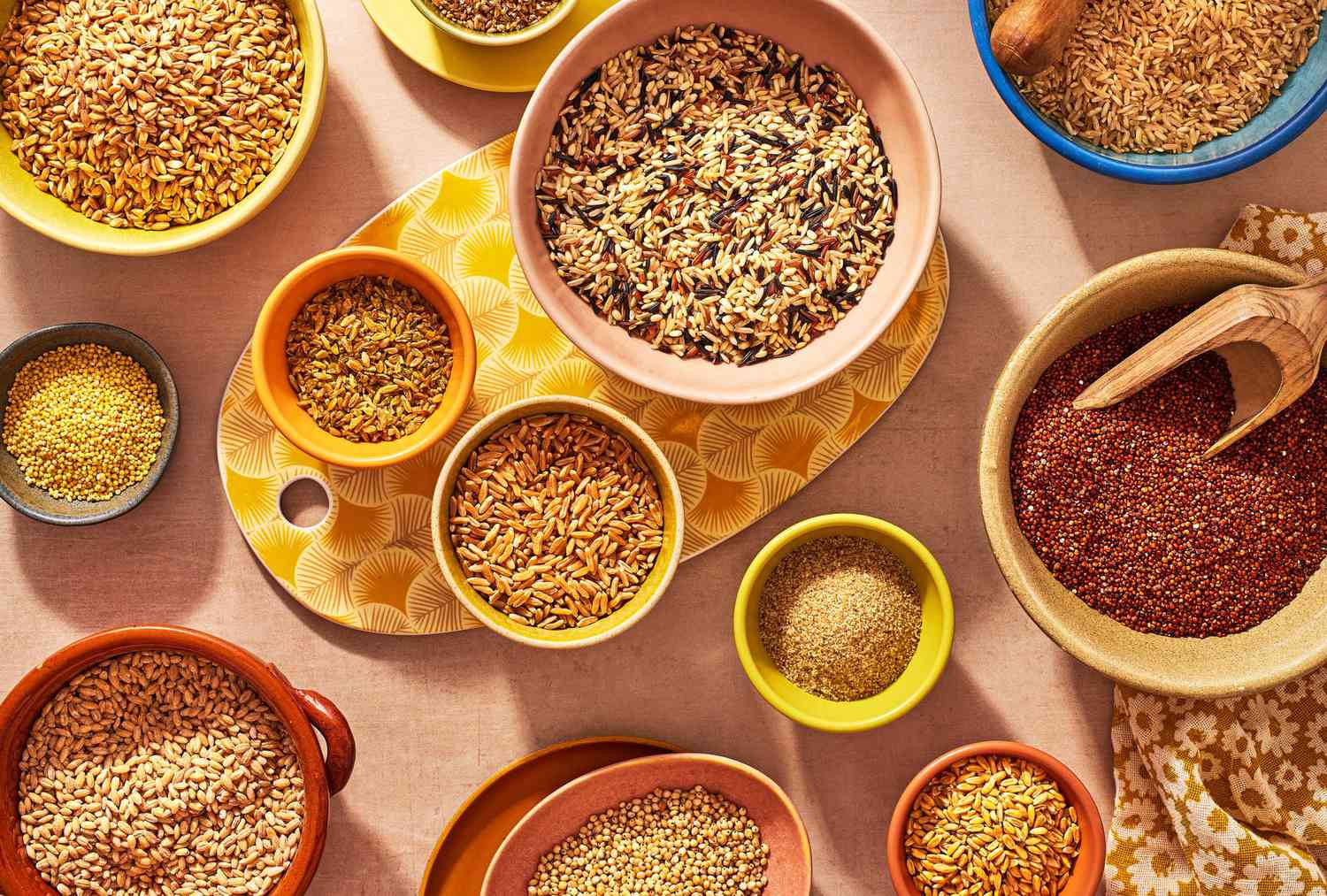Whole grains have forever been a staple of a healthy diet, and when you go to the market today, you’ll track down a lot of decisions — some of which you might not as yet have tried.
Ashli Greenwald, an enlisted dietitian, explains what whole grains are and how they can work on your health, and gives tips on bringing new grains into your diet.
What is a whole grain?
“A whole grain is one that is not handled,” Greenwald explains. “It’s eaten or ready in its regular state, as it fills in the ground. Like that, you get every one of its parts: the grain, the microorganism and the endosperm, where all the fiber, minerals and healthy fats are.”
Handled and refined grain items are what customers are probably going to find in stores, she says. “Most business bread is made with grain that has had a portion of its parts taken out in handling so it endures longer on the rack, and regularly has a supple surface that is well known with American shoppers. ‛Enriched’ flour has had a portion of the vitamins set back in, yet it’s as yet not so healthy as eating whole grain flour and food varieties.”
Good Carbs: Whole Grain Health Benefits
Following quite a while of keeping away from “carbs,” individuals are rediscovering good (complex) starches, including whole grains. They’re good for you in more ways than one, Greenwald says.
Vitamins, Minerals and More
“Whole grains, as they’re filled in the ground, are loaded with supplements,” she says. “They can contain a few B vitamins and minor elements, like iron, zinc, magnesium and copper. A few whole grains are good wellsprings of protein.
“You likewise get phytonutrients: plant-based intensifies that can diminish aggravation and may bring down your possibilities creating coronary illness, diabetes and even a few sorts of malignant growth,” says Greenwald.
Gut Health and Weight Loss
Since they’re high in fiber, these food sources help you feel full and fulfilled, which can assist you with shedding pounds. And, dissimilar to refined carbs, for example, white flour, white bread, white pasta, cakes and different desserts, whole grains are less inclined to cause a spike in glucose.
Dissolvable fiber in these grains might assist you with bringing down your cholesterol. It additionally dials back absorption so you feel more full longer. As a little something extra, dissolvable fiber can go about as a prebiotic, giving sustenance to the good microbes that keep your gut healthy.
The other sort of fiber, insoluble fiber from the husks of whole grains, upholds entrail health and may forestall obstruction, gallstones, hemorrhoids and different distresses.
How many of these whole grains have you tried?
A portion of these whole grains can be found on the racks of huge supermarkets. Others can be found at more modest, specialty health food stores or natural business sectors. You could arrange more diligently to-find things on the web.
1. Amaranth
High-protein amaranth has been eaten in South America for thousands of years, and rumors from far and wide suggest that the Aztecs alluded to amaranth as the “food of eternality.” Greenwald prescribes amaranth to her patients since it’s exceptionally nutritious, gluten free and simple to heat with. “You can utilize a similar measure of amaranth flour as normal flour in many recipes,” she says.
Tips for Amaranth Recipes
You can pop amaranth like popcorn.
Amaranth flour can work in sans gluten baking, like biscuits.
The unmistakable, marginally fiery flavor functions admirably with corn and squash dishes, and coordinates pleasantly with cinnamon in sweets.
2. Barley
Like wheat, barley comes from a plant that is essential for the grass family. Whole grain barley (not “pearl”) has an engaging, nutlike flavor. It contains gluten, so assuming that you have celiac infection, you’ll have to keep away from it. Splashing or growing barley gives you significantly more advantage by making its supplements more absorbable by the body.
Tips for Barley Recipes
Heat some bread with grew barley flour — a nourishing force to be reckoned with contrasted and plain flour.
Add surface to soup with whole grain barley rather than white rice.
3. Bulgur
Bulgur, Greenwald explains, is broken wheat that has been somewhat cooked and then dried. It’s the fundamental fixing in tabbouleh, a Center Eastern dish seasoned with mint, parsley and tomatoes. Yet, it’s unimaginably flexible, and its quick cooking time (10 minutes) makes it a nutritious go-to for occupied individuals who need to integrate whole grains into their diet.
Tips for Bulgur Recipes
Bulgur is delicious with a straightforward dressing of lemon, olive oil, salt and pepper.
It very well may be added to natively constructed veggie burgers or vegan stew.
It makes a good filler for meatballs and meatloaves.
4. Farro
Farro alludes to any of three antiquated grains from the Triticum family, first developed and eaten a while back. It is as yet well known in Tuscan and other Mediterranean cooking. Notwithstanding incredible taste, the enormous, whole-grain adaptation of farro gives healthy fiber and protein. Its wonderfully chewy surface holds up well, even in soups and stews. The whole grain variant of farro is more nutritious than the husked or “pearled” type.
Freekeh is one more type of wheat. The grain is gathered while still green, and cooked for a magnificent character. It very well may be utilized in recipes calling for quinoa, wheatberries or farro.
Tips for Farro Recipes
Drench whole grain farro short-term prior to cooking.
Prepare with kale and different veggies for a delightful serving of mixed greens.
Add to soups or present with a sprinkle of olive oil and flavors.
5. Millet
Millet — a little, hard grain — is the fundamental fixing in bird seed. However, it is likewise a protein-rich whole grain eaten by individuals in many nations all over the planet. Millet, as a yield, is commended for its solidness and simplicity of development. In Chinese cooking, millet can be the premise of a hot, exquisite porridge called congee.
Tips for Millet Recipes
Millet fits Asian food, and can be served rather than rice with pan sear dishes.
Attempt millet cooked and served hot as a morning meal cereal.
It tends to be prepared and squeezed into patties for veggie burgers.
6. Whole Oats
Not at all like the handled, sugar-loaded flavor bundles of moment oatmeal, whole oats or the steel-cut assortments provide you with every one of the benefits of this adaptable grain. And it’s not only for breakfast anymore.
Tips for Whole Oat Recipes
Appreciate whole oats for breakfast in hot oat, muesli or biscuits.
Add new whole berries for cancer prevention agent power.
Attempt whole oats as a healthy option in contrast to breadcrumbs utilized as extenders in burgers or meatloaf.
7. Quinoa
Articulated “Sharp wah,” this flexible, sans gluten grain is really a consumable seed. It is a healthier substitute for white rice, and can be had as a hot breakfast dish, a base for salad, an expansion to soup and considerably more. Greenwald brings up that quinoa is a finished protein source, with each of the nine amino acids that our bodies need to get from food sources we eat.
Tips for Quinoa Recipes
There are more than 100 sorts of quinoa. White and yellow sorts have the mildest taste; dark quinoa has the most serious flavor.
Make certain to wash the quinoa completely prior to cooking.
At the point when the pale quinoa structure starts to isolate from within microbe, it’s finished.
8. Sorghum
What is sorghum? Like corn, it’s a fundamental whole grain utilized for making fuel and taking care of creatures and individuals, yet takes undeniably less water to develop and develops rapidly, and so it is more harmless to the ecosystem. Sorghum is initially from Africa, and first showed up on Southern American tables as a fixing in molasses. It is stuffed with cell reinforcements, vitamins and minerals, however no gluten. Every half-cup has 10 grams of protein, which makes it both nutritious and filling.
Tips for Sorghum Recipes
Sorghum has establishes in African legacy cooking, and functions admirably with Creole and Cajun dishes and flavors.
Connoisseur eateries are involving it in flatbreads and Spanish-style rice dishes.
Take a stab at preparing it with dressing and veggies for a filling and nutritious serving of mixed greens or pita filling.
9. Teff
These minuscule grains of goodness give a gentle, nutty flavor alongside iron and different minerals. Teff flour is utilized to make injera, the delightful flatbread used to gather up stews in customary Ethiopian and Eritrean cooking. Since the sans gluten grains are so little, there is a high extent of microorganism and wheat, the most nutritious pieces of whole grains.
Tips for Teff Recipes
Greenwald says teff makes a brilliant hot cereal, and can be ready as a polenta or side dish.
You can make a short-term porridge with teff by adding water and placing it in the cooler short-term.
At the point when arranged like rice, teff can be prepared in 15 or 20 minutes.
Whole Grains and Gas
Certain individuals wonder whether or not to partake in the benefits of whole grains since they’re worried about bloating or intestinal gas. On the off chance that your framework isn’t utilized to healthy, high-fiber food sources, Greenwald says bringing whole grains into your diet continuously can assist with staying away from these side effects. “Begin with more modest servings,” she proposes, “and ensure you increment how much water you drink.”
Over the long run, you might see healthier processing. When whole grains become a backbone in your feasts, you are more liable to stay away from clogging, which is a typical reason for intestinal gas and bloating.
Whole Grains and Your Healthy Diet
Greenwald says whole grains can add a ton of helpful supplements and flavor to your feasts. “Mindfully incorporating whole grains into feasts can augment the health benefits they give,” she says.
“Involving healthy plate rules for segments, your serving of whole grains ought to take up around 25% of your plate, with lean protein taking up another 25% and vegetables covering the leftover half,” she suggests.
Relevant Content Search:
healthiest grains |
is farro a whole grain |
healthy grains |
healthy whole grains |
farro nutrition |
healthiest grains to eat |
healthiest grains for weight loss |
healthiest grains for dogs |
what are the 5 healthiest grains |
healthiest grains for breakfast |
healthiest grains ranked |
the healthiest grains |
what are the healthiest grains |
healthiest grains and legumes |
what are the 5 healthiest grains? |
top 10 healthiest grains |
what are the healthiest grains to eat |
world’s healthiest grains |
what are the healthiest grains for dogs |
healthiest grains for vegans |
healthiest grains list |
list of healthiest grains |
healthiest grains in the world |
what are the healthiest grains to consume? |







